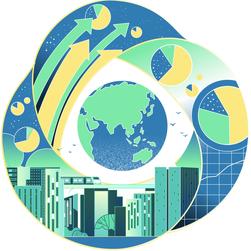 (SHI YU / CHINA DAILY)
(SHI YU / CHINA DAILY)
Every day, we are bombarded with headlines and news flashes. Reading those pings, we could all be forgiven for asking: "Will this year be any different from the last?"
Infection rates are still high, travel restrictions still tight and jobless rates face a lagged hit. The geopolitical landscape appears as febrile as ever. Amid the lackluster news flow, it is easy to overlook the profound shifts which are rapidly taking shape.
Caveats aside, Asia is the beating heart of the world and there is no doubt that it will pump vibrancy back into the global economy
Here in Asia, there are increasing reasons for optimism though. Home to more than half of the world's population and a rising middle class, the region is experiencing accelerated structural shifts in its business landscape due to the COVID-19 pandemic and geopolitics. Globalization is giving way to regionalization. Fundamental changes are happening in supply chain approaches, trade pacts, digital and consumption patterns, and financial innovation.
Solid economic recovery of China
Although the pandemic set back progress, the region's policymakers have acted decisively to mitigate its impact. In particular, China's effective pandemic control led to a solid economic recovery and positive GDP growth from the second quarter of 2020, making it the only major economy to avoid COVID-19-induced recession. As it stands, Asia is rebounding faster than the rest of the world. Research estimates Asia's growth at 7.5 percent in 2021, with China, registering 8 percent growth, spearheading the global economic revival.
Slingshotting the comeback will be the Regional Comprehensive Economic Partnership. The RCEP, which already accounts for half of Asia's trade volume, is expected to further boost intra-Asian trade. Having China in its corner will be beneficial, given that the country surpassed the US to become the largest recipient of foreign investment for the first time in 2020. With harmonization of trade standards, the RCEP's added connectivity will bolster a rapidly rising North-South corridor.
Supply chain shifts precipitated by US-China tensions on top of the already revved-up engine of Asia's emerging consumer base will bring about a structural rebalancing of global trade corridors. The East will increasingly be producing for the East. And other advances-including enhanced connectivity within the Guangdong-Hong Kong-Macao Greater Bay Area and across ASEAN-will add whirls of vitality.
After all, Asia is in a different place to where it was even a year ago. The COVID-19 pandemic has wrought structural changes, but it is these exact shifts that are presenting underrated opportunities. Through a wider lens, I see in Asia new supply chain dynamics and digital innovation creating jobs, transforming skill requirements, and remaking economies.
Experiencing last year's growing fragility of the international supply chains, those businesses quick to adapt have re-engineered their approach to sustain growth. With certainty of supply now valued as highly as costs and speed-to-market, supply-chain participants have rebalanced their priorities, focusing on a "just-in-case" model with greater emphases on self-sufficiency and business continuity.
To ensure resilient growth, there is increasingly a recognition that a unique opportunity lies in the area of sustainability. Sustainable practices go beyond building a green environment; commitment to sustainability is Asia's future. Take for example China's ambitious goal to realize carbon emissions peak by 2030 and carbon neutrality by 2060. It can create many opportunities for regional and global cooperation in green development.
The pandemic has also brought digitalization to the fore, compelling traditional and new players alike to adopt technology to ensure resilience and sustainability.
Everything from education, shopping, food and healthcare are shifting online. Asia has already surpassed the West in terms of the share of e-commerce retail sales, with the fastest growth coming from India, China and Indonesia.
Governments are also accelerating digital interconnections. The Chinese mainland's digital currency, Singapore's Networked Trade Platform and the Hong Kong Special Administrative Region's eTrade-Connect all serve to bring greater connectivity to facilitate trade and payment flows.
Act now and act decisively
A year from now, the world could look vastly different from what it is today, just like how it did 12 months ago. At the heart of a resurgent Asia will be fast-changing digitalization dynamics against a rapidly evolving context.
For the bold and decisive, it is this backdrop in Asia that provides a unique, broad, and exciting canvas-albeit a fragmented one. No single business player has dominated any sector in Asia as Google, Amazon or Apple have in the United States and around the world. Take messaging apps: LINE dominates in Taiwan region and Japan, whereas WeChat and WhatsApp are popular in other parts of Asia. Likewise for e-commerce platforms, ride-hailing apps, and payment wallets.
Recognizing that this gap exists is key-it's indicative of the potential opportunities that are available. Businesses that act upon what Asia has to offer today will be well placed to emerge as tomorrow's leaders. And that reinforces another element: time is of the essence, and the first-mover advantage is real.
Aggressive approach
Prospective players, therefore, need to approach this market with an aggressive, dominant-player and fail-fast-learn-fast mentality. Companies that look to revamp their strategies now while factoring in the profound structural shifts underway will make a meaningful impact.
Success in Asia is unlikely to be straightforward. Much will also depend on extraneous factors, including regional stability, US-China relations, the speed by which the pandemic can be controlled, and how governments implement their public policies. Asia also faces substantial risks in climate change, where public and private sectors' ability to heed sustainability considerations to generate long-term economic growth will be critical.
Caveats aside, Asia is the beating heart of the world and there is no doubt that it will pump vibrancy back into the global economy.
My message, then, is simple: Don't wait too long to act.
As Asia beckons, China is a beacon of hope!
The author is CEO of Asia, Standard Chartered.
The views don't necessarily reflect those of China Daily.


